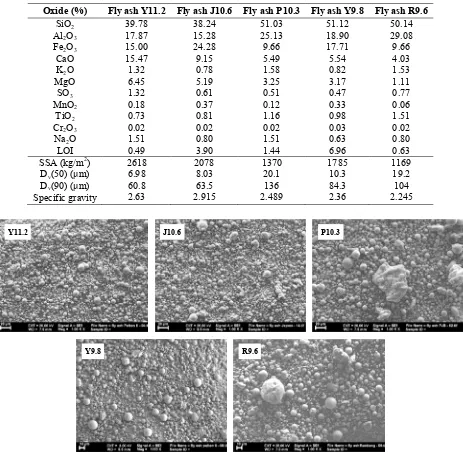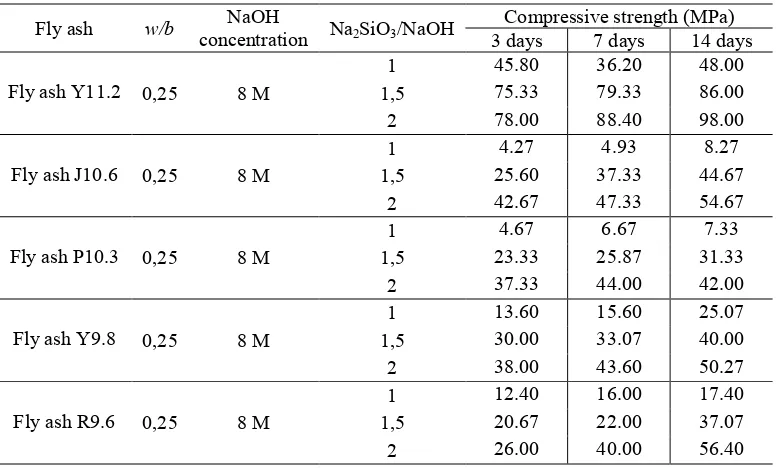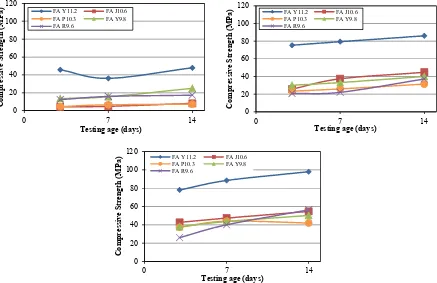Compressive Strength of Geopolymer Based on the Fly Ash Variation
ANTONI
1,a*, STEPHEN Wibiatma Wijaya
2,band DJWANTORO Hardjito
1,c1Department of Civil Engineering, Petra Christian University, Indonesia
2Post Graduate Program in Civil Engineering, Petra Christian University, Indonesia
a[email protected], b[email protected], c[email protected]
Keywords: geopolymer, fly ash, CaO content, specific surface area, strength
Abstract. This study was conducted to determine the factors that may affect the compressive strength of fly ash-based geopolymer. With so many kinds of fly ash available and has its different characteristics, it would be very influential on geopolymer produced. These effects is classified into internal and external of the fly ash material. Internal influences include the physical and chemical properties of the fly ash, while external influences associated with mixture of geopolymer and the manufacturing process. From the experiment results, it was found that the size of the granules, the content of CaO and MgO, and carbon content in fly ash that are internal factors that may affect the compressive strength. While the ratio of sodium silicate and sodium hydroxide in the alkaline solution and NaOH molarity used can also give a direct influence on the compressive strength of geopolymer.
Introduction
One of the use of fly ash is as a raw material for manufacturing geopolymer concrete, because the fly ash contains silica (Si) and alumina (Al) so it can form a polymerization reaction when mixed with strong alkali [1]. In the making of geopolymer concrete, the quality of fly ash used, both physical and chemical characteristics influence the process and the end result. In general, the characteristics of fly ash is closely related to the type of coal used. This is consistent with studies that have been carried out [2] that the physical properties and chemical content of fly ash influenced from the type of coal, coal burning techniques, the mineral content, method of collection, long storage time, and the sampling period. Therefore, although the fly ash comes from the same place can have different characteristics.
Reactivity of fly ash in its use as a geopolymer concrete is also greatly influenced by the particle size (surface area), the content of amorphous materials (glass content), and the chemical composition of the constituent (glass composition) [3]. The main chemical content in fly ash in the
form of SiO₂, Fe₂O₃ and Al₂O₃ are generally used to classify the fly ash type. The content of CaO
also contribute to the characteristics of the fly ash. In previous studies [4,5], high levels CaO in fly ash has an advantage that it can produce high compressive strength, because the polymerization reaction and hydration reaction occurs together. CaO content is related to the pH value measured in fly ash [6,7].
In the formation of geopolymer concrete, alkaline activator is needed as an activator of the polymerization reaction of silica and alumina contained in fly ash. The alkaline solution most
commonly used is a combination of sodium hydroxide (NaOH) and sodium silicate (Na₂SiO₃).
With the high concentration (molarity) of a sodium hydroxide solution, the resulting compressive strength also becomes higher. Similarly, the ratio between sodium silicate and sodium hydroxide, with higher ratios used, produce geopolymer concrete compressive strength of the higher [8]. By looking at various factors that could potentially affect the compressive strength of geopolymer, this study intends to determine the contribution of these factors from the properties of the fly ash and the mixture composition.
Experimental Method
Material. Fly ash used as a base material in this study came from different coal power plant in East Java. Five types of fly ash originating from Paiton, Probolinggo unit 5&6 (coded Y11.2 and Y9.8), Paiton unit 1&2 (coded P10.3), Tanjung Jati, Jepara (coded J10.6) and Rembang (coded R9.6). Each fly ash was coded in addition with the pH measured in aqueous solution of 20 gr fly ash in 80 ml deionized water. In each fly ash sample, physical testing such as particle size distribution, specific gravity and scanning electron microscope (SEM) was conducted. In addition to the physical examination, x-ray fluorescence (XRF) also was conducted to see the chemical content of fly ash. Results of XRF and the physical properties of the fly ash can be seen in Table 1. Results of the SEM is shown in the Fig. 1.
Table 1. Fly Ash chemical composition and physical properties
Oxide (%) Fly ash Y11.2 Fly ash J10.6 Fly ash P10.3 Fly ash Y9.8 Fly ash R9.6
SiO2 39.78 38.24 51.03 51.12 50.14 Al2O3 17.87 15.28 25.13 18.90 29.08 Fe2O3 15.00 24.28 9.66 17.71 9.66
CaO 15.47 9.15 5.49 5.54 4.03 K2O 1.32 0.78 1.58 0.82 1.53 MgO 6.45 5.19 3.25 3.17 1.11 SO3 1.32 0.61 0.51 0.47 0.77 MnO2 0.18 0.37 0.12 0.33 0.06 TiO2 0.73 0.81 1.16 0.98 1.51 Cr2O3 0.02 0.02 0.02 0.03 0.02 Na2O 1.51 0.80 1.51 0.63 0.80 LOI 0.49 3.90 1.44 6.96 0.63 SSA (kg/m2) 2618 2078 1370 1785 1169 Dv(50) (µm) 6.98 8.03 20.1 10.3 19.2 Dv(90) (µm) 60.8 63.5 136 84.3 104 Specific gravity 2.63 2.915 2.489 2.36 2.245
Figure 1. SEM micrograph of the fly ash used.
From the SEM photo it can be seen that it have some correlation with the specific surface area (SSA) measured. The greater the value of SSA shows that grains are also finer. The SEM also shows that each sample of fly ash has a different form of particle shape, especially on fly ash R9.6 and P10.3, which have some irregular shape particle and larger globule.
Y11.2 J10.6 P10.3
According to the standard ASTM C618 [9], the classification of fly ash based on the content of
the main chemical compound in the form of SiO2, Fe2O3 and Al2O3. Samples of fly ash used meets
the standards of the three main compounds in which the number is more than 70%, while based on the content of CaO, fly ash Y11,2 is classified as type C fly ash, while the remaining four is type F fly ash.
Sand from Lumajang in saturated surface dry (SSD) condition and fineness modulus of 2.52 was used for making all of the mixture. Alkaline solution as an activator of the polymerization reaction
was made from solution of sodium hydroxide (NaOH) and sodium silicate (Na2SiO3).
Mix proportion. The experimental study was conducted in geopolymer mortar were made in accordance with a mixture of solution to binder ratio of 0.25, sand to binder ratio of 2 for all fly ash type. Sodium hydroxide (NaOH) solid were dissolved in water with molarity of 8M one day prior mixing. Ratio of alkaline solution which are Sodium Silicate liquid to Sodium Hydroxide solid
(Na2SiO3/NaOH) used is 1; 1.5; and 2.
Specimen preparation and testing. The NaOH solution in accordance with a predetermined ratio was made one day before mixing. Fine aggregate and fly ash is mixed in advance to make a uniform dried material. Mixing an alkaline solution containing sodium hydroxide liquid and sodium silicate liquid was done prior mixing with the binder and then with the aid of a hand drill and a table vibrator all material are mix to ensure uniform mixing and all done in less than 5 minutes. Casting is done on the cube formwork measuring 50×50×50 mm. After casting, plastic sheet was wrapped in the formwork to avoid excessive evaporation. Curing was done in oven with a temperature of 60°C for 24 hours. After that, the specimen can be demolded and it was stored at room temperature until testing time. Compressive strength testing conducted on mortar aged 3, 7 and 14 days. From each mix design, three specimens are averaged to obtain the compressive strength data.
Results and Discussions
Compressive strength. The compressive strength result is shown in Table 2. There is a wide range of the strength result based on the composition and material source. Lower strength was expected from lower ratio of sodium silicate to sodium hydroxide, but the trend of increment was not same for each fly ash used. There are some strength increase even using oven curing for 3 days, 7 days and 14 days testing.
Table 2. Compressive strength of thegeopolymer mortar
physical properties of fly ash is shown in Fig. 2(a). With the finer particle size of fly ash shown by the higher value of SSA, showed a strong prospect in achieving higher compressive strength.
Figure 2. Compressive strength at 14 days with relation to (a) Specific surface area and (b) Lost on ignition of the fly ash.
Figure 3. Compressive strength at 14 days with relation to (a) CaO content and (b) MgO content of the fly ash.
Combustible material contained in fly ash is shown as the LOI value, where the higher the LOI value shows a high carbon content in fly ash. Fly ash Y11.2 and R9.6 have LOI value of 0.49% and 0.63%, which shows the content of which is quite low compared to other samples of fly ash which has a LOI value above 1.00%. By looking at the correlation between LOI content with the compressive strength of mortar produced as shown in Fig. 2(b), it was shown to have slight tendency that with lower carbon content in fly ash produces a higher compressive strength, especially with the content of below 1%.
The XRF test results also show the constituent chemical compounds content of fly ash. The content of CaO and MgO is shown to be directly proportional to the pH value of fly ash. With the higher the content of CaO and MgO, the pH value of fly ash is also higher. Furthermore, when it was correlated with the compressive strength result as shown in Fig. 3, it was recorded that content of CaO and MgO in the fly ash can affect the compressive strength in geopolymer because CaO also affects the reactivity possessed by the fly ash [9]. The higher CaO content would cause not only polymerization reaction but also hydration reaction that can improve the compressive strength obtained. However, the MgO content in fly ash is not yet known to have beneficial effect on the compressive strength because effect of MgO on the geopolymer could also compensate the geopolymer shrinkage [10].
For the record, the use of five kinds of fly ash in this research have significant different sources and chemical content. The higher strength could be influenced from the combination of several factors.
(Na2SiO3/NaOH), and also the molarity of NaOH solution. Effect of solution to binder ratio, the
molarity of NaOH solution and curing temperature was not investigated, but should be noted that they will also have significant effect on the compressive strength [7]. Fig. 4 shows the test results of the compressive strength of geopolymer mortar from different fly ash source. It was clearly shown
that the ratio of Na2SiO3/NaOH have significant effect on the compressive strength of the
geopolymer mortar. Lower ratio resulted in low compressive strength less than 20 MPa with the
exception of fly ash Y11.2. At Na2SiO3/NaOH ratio of 2, it was shown that the concrete have higher
strength with fly ash Y11.2 could reach up to 98 MPa for 14 days strength, while for other fly ash it could reach between 42 to 56 MPa. Fly ash Y11.2 produces much higher compressive strength compared to other fly ash, despite having exactly the same mixture. Given that the fly ash Y11.2 is the only high calcium fly ash in this study, it was more likely that the internal effect makes more difference in strength gain.
Figure 4. Compressive strength at 14 days for mortar made with different fly ash
for ratio of Na2SiO3/NaOH at (a) 1, (b) 1.5 and (c) 2.
Conclusions
Compressive strength of geopolymer-based fly ash produced can be influenced by internal and external factors. Internal factors include the physical and chemical properties of fly ash. With more emphasis on the particle size distribution and its particle shape with finer particle would have higher reactivity and thus higher strength.
The chemical content of fly ash in the form of CaO and MgO, from the results of this study, also showed a strong influence on compressive strength where high content of CaO and MgO increase the strength. Carbon content shown on the LOI value indicates lower value especially under 1%, can produce higher compressive strength. However, further research is needed on this result because between compounds feared the dominant influence of a chemical compound that exist and influence the results obtained.
External factors such as mix design and process, which include alkaline solution and NaOH molarity used, can affect the compressive strength of geopolymer. With the lower alkali content and molarity of NaOH, also produces lower compressive strength.
Acknowledgements
The authors gratefully acknowledge The Directorate General for Higher Education, Ministry of Research, Technology and Higher Education, Indonesia, who provided the research grant through
the ‘Hibah Kompetensi’ scheme in 2014 and 2015.
Reference
[1] J. Davidovits, Geopolymer chemistry and applications, 2nd ed. Saint-Quentin, France: Institute Géopolymère, 2008.
[2] J. J. Ekaputri, K. A. Priadana, T. E. Susanto, and S. Junaedi, “Physico-chemical characterization of fly ash,” World Congr. Adv. Struct. Eng. Mech. Jeju, Korea, pp. 2988– 2996, 2013.
[3] S. Kumar and R. Kumar, “Mechanical activation of fly ash: effect on reaction, structure and properties of resulting geopolymer,” Ceram. Int., vol. 37, no. 2, pp. 533–541, 2011.
[4] J. J. Ekaputri, U. M. Bahrul, R. Bayuaji, S. T. Eddy, M. M. Al Bakri, and M. I. Triwulan, “A comprehensive characterization and determination of fly ashes in Indonesia using different methods,” Appl. Mech. Mater., 2015.
[5] T. Phoo-ngernkham, P. Chindaprasirt, V. Sata, and T. Sinsiri, “High calcium fly ash geopolymer containing diatomite as additive,” Indian J. Eng. Mater. Sci., vol. 20, no. 8, pp. 310–318, 2013.
[6] Antoni, R. Gunawan and D Hardjito, “Rapid Indicators in Detecting Variation of Fly Ash for Making HVFA Concrete” Appl. Mech. Mater. Vol. 815 (2015) pp 153-157
[7] M. Izquierdo and X. Querol, “Leaching behaviour of elements from coal combustion fly ash: An overview,” Int. J. Coal Geol., vol. 94, no. 5, pp. 54–66, May 2012.
[8] D. Hardjito and B. V. Rangan, “Development and properties of low-calcium fly ash-based geopolymer concrete,” Curtin University of Technology. Perth, Australia, 2005.
[9] ASTM C618, Standard specification for coal fly ash and raw or calcined natural pozzolan for use in conrete. ASTM International, 2003.



